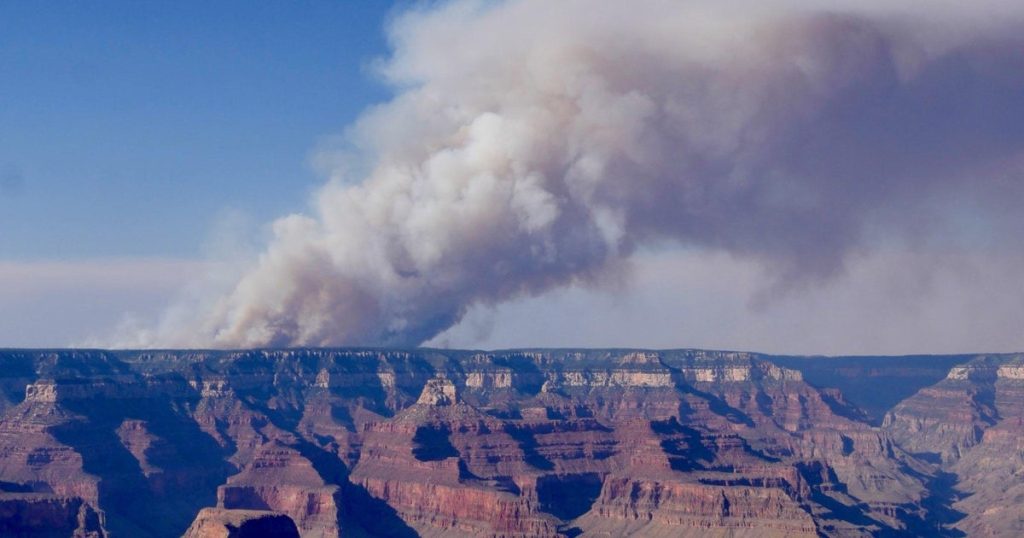An intense wildfire season is impacting areas around the Grand Canyon National Park in Arizona, where the White Sage Fire has rapidly expanded, forcing hundreds from their homes. This fire, along with the nearby Dragon Bravo Fire, has wreaked havoc as the region grapples with detrimental air quality due to smoke from Canadian wildfires. Authorities are on high alert, warning of worsening conditions that challenge firefighting efforts and impact public health across several states.
| Article Subheadings |
|---|
| 1) Overview of Current Wildfires |
| 2) Impact of Smoke on Air Quality |
| 3) Weather Conditions Affecting Fire Containment |
| 4) Responses and Evacuations in Affected Areas |
| 5) Wider Implications of Wildfire Season |
Overview of Current Wildfires
The White Sage Fire has surged to over 20,000 acres in size within just 24 hours, occurring in the Kaibab National Forest. This intense growth has caused local officials to evacuate hundreds of residents. According to the U.S. Forest Service, this fire, alongside the Dragon Bravo Fire, has been attributed to lightning strikes. As emergency services attempt to contain these flames, they face considerable challenges due to the escalating wildfire season, which has also seen the return of Canadian wildfire smoke blanketing parts of the U.S.
Impact of Smoke on Air Quality
While firefighting crews battle the flames in Arizona, onlookers in regions like the Upper Midwest are grappling with declining air quality. Smoke from Canadian fires has led to alarming air quality levels, with parts of Minnesota, Montana, North Dakota, and Wisconsin reporting “unhealthy” air. Defined by the U.S. Environmental Protection Agency, some areas even reached “very unhealthy” levels, prompting warnings from local health officials.
This decline in air quality is particularly disheartening during the summer months when residents hope to enjoy outdoor activities. Notably, the tourist-heavy region near Theodore Roosevelt National Park in North Dakota has recorded some of the worst air quality in the nation, forcing many locals and visitors indoors. Many experts advise the population to limit outdoor activities to safeguard their health, particularly for those with pre-existing lung conditions.
Weather Conditions Affecting Fire Containment
The National Weather Service has raised alarms about the extreme weather conditions coinciding with the wildfire crisis. Hot temperatures surpassing 110 degrees in parts of Arizona are exacerbating the situation, rendering efforts to contain these wildfires more complex. The high temperature is coupled with smoke and high fire danger warnings, leading officials to stress caution for those venturing outdoors.
There have been dire consequences as a result of these conditions; for instance, a 67-year-old hiker from Texas tragically lost his life while trekking in the Grand Canyon. The combination of heat and smoke creates an environment that is both hazardous for wildland firefighters and potentially deadly for recreationalists.
Responses and Evacuations in Affected Areas
In response to growing wildfire threats, more than 200 firefighters and additional personnel have been deployed to tackle the White Sage Fire, which continues to evolve at an alarming rate. The fire has spread across a high-altitude plateau, creating challenges in access and required resources. Local authorities are vigilant; the Dragon Bravo Fire, begun on July 4, is also under scrutiny.
In addition to Arizona, Manitoba, Canada, is experiencing its own crisis with widespread wildfires leading to a state of emergency. More than 12,600 people have been evacuated due to the raging fires that have consumed vast areas. While the situation is dire in Canada, under 1,000 individuals have evacuated their homes in Saskatchewan, indicating a potential need for more comprehensive responses as conditions worsen.
Wider Implications of Wildfire Season
As this wildfire season unfolds, it presents significant implications for public health, environmental stability, and local economies. Many urban centers are facing health risks associated with deteriorating air quality, impacting those engaged in outdoor activities. As businesses, such as resorts near lakes, begin to adjust their services or even close due to air quality issues, concerns about economic repercussions grow.
The current wildfire situation serves as a grim reminder of the realities of climate change and the challenges it presents. Local economies depending on tourism are particularly vulnerable; for example, the owner of a resort near Detroit Lakes expressed frustration as the smoke hampers summer activities. This enigma—balancing public safety and economic interests—will challenge leaders and residents alike as they navigate the ongoing crisis.
| No. | Key Points |
|---|---|
| 1 | The White Sage Fire has expanded rapidly, forcing mass evacuations. |
| 2 | Smoke from Canadian wildfires has caused unhealthy air quality across several states. |
| 3 | Extreme weather conditions are complicating firefighting efforts. |
| 4 | Over 200 firefighters are actively working to contain the fires. |
| 5 | The ongoing crisis raises concerns about public health and local economies. |
Summary
As the wildfire season escalates, the impacts on human lives, public health, and local economies become increasingly pronounced. The rapid spread of the White Sage and Dragon Bravo Fires has led to urgent evacuation measures, while smoke from these fires jeopardizes air quality across the Midwest. In light of worsening climatic conditions, officials urge caution and preparation as communities confront the pressing challenges posed by wildfires.
Frequently Asked Questions
Question: What are the primary causes of the current wildfires?
The wildfires are primarily attributed to lightning strikes, according to officials from the U.S. Forest Service.
Question: How is smoke from wildfires affecting air quality?
Smoke from wildfires reduces air quality significantly, leading to warnings from the U.S. Environmental Protection Agency in several states, affecting outdoor activities and public health.
Question: What safety measures should residents take during wildfire season?
Residents are advised to limit outdoor activities, keep windows closed, use air purifiers, and stay informed about evacuation orders and air quality updates.


